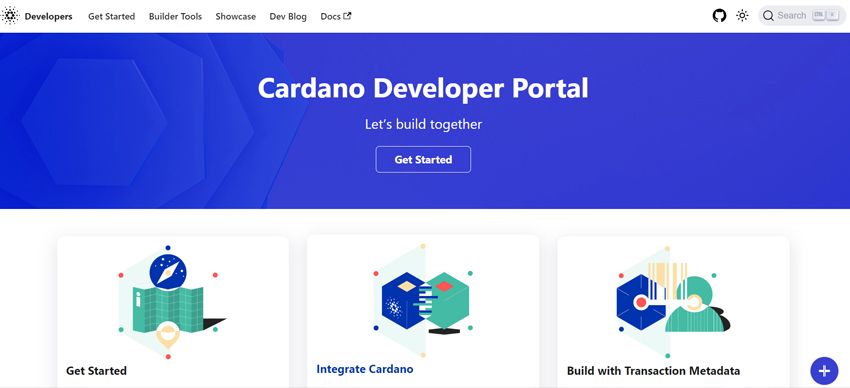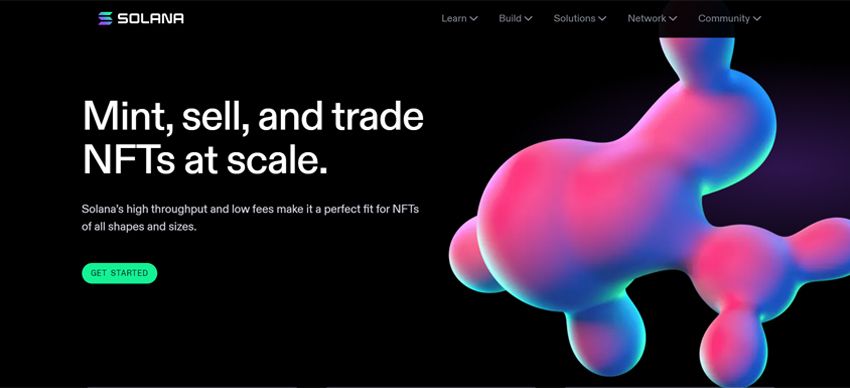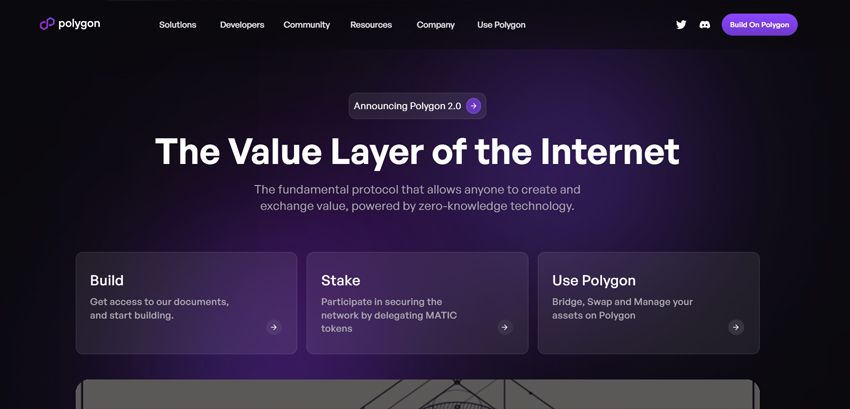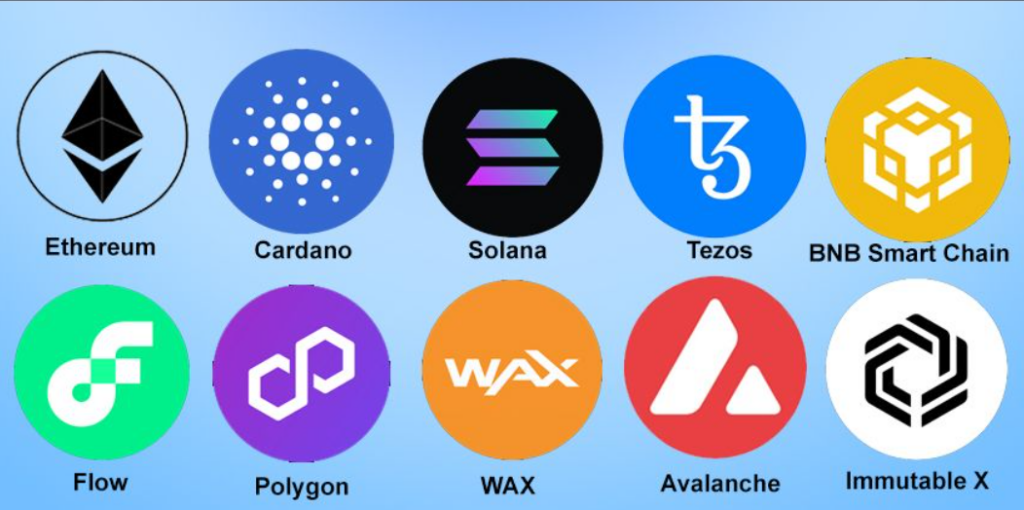Non-fungible tokens (NFTs), programmable units of unique data that cannot be modified once recorded in a distributed ledger, are created by companies, creators, and developers using a number of blockchains. However, because each blockchain has its own set of advantages and disadvantages, it’s critical that these companies, producers, and developers grasp the differences before deciding which blockchains are appropriate for their NFT campaigns.
In this article, we review the top 10 blockchains for developing NFTs.
10 Best Blockchains for Developing NFTs
Ethereum
Ethereum is the most commonly used blockchain for NFTs. It provides the legal and financial services essential for transactions without the use of middlemen due to its great decentralization.

Ethereum is ideal for establishing new projects because it is well-established and has a big user base. It also hosts some of the most popular NFT projects, such as Doodles and the Bored Ape Yacht Club; NFT artists, such as Beeple and Pak; and NFT marketplaces, such as OpenSea and Axie Infinity.
Cardano
Cardano is a complicated, decentralized proof-of-stake blockchain that is popular for NFTs due to its sustainability, security, and scalability. Cardano wants to build a strong ecosystem for developing decentralized apps and markets for artists and collectors by allowing transactions in its native cryptocurrency, ADA.

All Cardano operations, including minting, purchasing, and selling NFTs, involve fees that are determined by the size of the files being transferred. Therefore, larger files will incur a higher fee than smaller files.
A well-known Cardano NFT marketplace is CNFT.io, which is home to Cardano NFTs like Clay Nation, SpaceBudz, and Clumsy Ghosts.
Solana
Solana, the second largest NFT blockchain, has a developing NFT ecosystem. It addresses certain blockchains’ transaction speed constraints and scalability difficulties, such as Bitcoin and Ethereum. Solana’s minimal costs and quick transaction speeds make it an excellent choice for any type of NFT.

However, the blockchain is not as popular as Ethereum, and it has attracted criticism from individuals who believe it is not sufficiently decentralized. Solana experienced several slowdowns and halts in 2022, forcing the blockchain to rethink how it processes inbound traffic.
Bored Ape Solana Club, Degenerate Ape, and Smyths are some of the best NFT collections on Solana. These NFTs are available for trading on Solana-based NFT marketplaces like as Yawww, Hyperspace, and Solsea.
Tezos
Tezos, an open-source, decentralized blockchain, allows for smooth peer-to-peer transactions. It is ideal for NFT artists who want to mint NFTs successfully due to its minimal expenses. Building their creations on the blockchain allows people to connect to the enormous Tezos community of developers, collectors, artists, and merchants. The cost of minting NFTs, as well as related fees, is lower on Tezos than on most other NFT marketplaces, including the Ethereum ecosystem.

With the Tezos FA2 standard, users can create single and multi-token smart contracts. Tezos employs the proof-of-stake consensus mechanism, which consumes less energy than proof-of-work systems.
BNB Smart Chain
The BNB Smart Chain is made up of two blockchains: the BNB Smart Chain (formerly known as the Binance Smart Chain), which supports NFT projects, and the BNB Beacon Chain (previously known as the Binance Smart Chain), which supports staking, voting, and other governance initiatives. NFTs are developed on the BSC with attention to interoperability with other blockchains.

NFT developers also use the BNB Smart Chain platform for their applications because it is more affordable and quick than other blockchains, in addition to its cross-chain compatibility and support for the Ethereum Virtual Machine (EVM).
Flow
Flow is a high-performance blockchain designed primarily to let users build apps, NFTs, and big-scale crypto games. Flow is designed for speed and scalability. Additionally, it is developer-friendly, which is essential for making the blockchain the leading platform for game developers, autonomous decentralized organizations, and NFT producers.

NBA Top Shot, the NFT marketplace where basketball fans can purchase, sell, and exchange National Basketball Association video clips and digital artwork, is the product that has gained Flow the most notoriety.
Polygon
Polygon is yet another Ethereum Layer 2 solution. It has been used to develop a number of NFT projects that have been successful on OpenSea and other NFT markets. NFTs such as The Martians, ZED Run, Chumbi Valley Official, Genesis Kosmos, and others are included. Using smart contracts, developers can create scalable solutions on the blockchain. It is EVM compliant, allowing for speedier transactions and lower gas expenses. Polygon NFTs can also be minted and sold on OpenSea and other marketplaces such as NFTrade. For these reasons, the Polygon Network is being used for an increasing number of NFT projects.

However, many people are still unfamiliar with Polygon. As a result, few individuals may be ready to acquire NFTs designed with Polygon, especially given that utilizing Polygon for the first time can be difficult for beginners.
The WAX (Worldwide Asset Exchange)
WAX is a blockchain platform created specifically for gaming and NFTs that promises to offer a user-friendly and accessible ecosystem for creators and collectors. To enable great scalability and quick block confirmation times, it uses a delegated proof-of-stake (DPoS) consensus process. William Shatner and other well-known figures, such as Capcom and Topps, have collaborated with WAX.

Numerous NFT markets, such as the WAX Marketplace and AtomicHub, are hosted by the WAX platform and allow users to purchase, sell, and exchange digital assets.
Avalanche
The Avalanche (AVAX) blockchain is currently one of the quickest smart contract platforms accessible. It is powered by a number of consensus methods that prioritize scalability, usability, and interoperability. AVAX charges cheap gas fees and has fast transaction speeds thanks to its Proof-of-Stake (PoS) protocol. For example, NFTs can be produced for far less than a dollar. It has a very low carbon footprint, as do other PoS blockchains.

On the flip side, Avalanche’s user interface is a little bit more challenging due to its three distinct chains, X, C, and P. Additionally, it doesn’t punish validators (slashing) for engaging in fraudulent or other bad activities, unlike other blockchains. Once you get acclimated to it, Avalanche is no more difficult to use than other networks because all of the NFTs on it are on the C-Chain, the same Avalanche network that MetaMask supports. The number of top-notch games and profile picture (pfp) collections joining the Avalanche community’s network has already increased and is expected to rise.
Immutable X
Layer 2 network Immutable X is based on Ethereum. This indicates that it is an additional protocol created to provide functionality to an already-existing blockchain system. Immutable X, in this instance, is based on the Ethereum blockchain. As a result, it eliminates some of Ethereum’s most serious flaws and establishes an open, decentralized ecosystem for creating NFTs.

When you mine NFTs on Immutable X, you avoid paying fees in peer-to-peer transactions. The layer 2 network is substantially quicker, with transaction fees of up to 9,000 TPS. It’s also very scalable because there won’t be any network congestion. Immutable X operates an NFT trading marketplace for developers. This marketplace has made it easier for small artists and developers to break into the industry. Still, as evidenced by its most recent large launch, the Illuvium Land Sale, the blockchain is capable of generating a lot of hype.
Illuvium has become one of the most successful NFT sales in history within 72 hours of its inception. A total of 20,000 land plots totaling $76 million were sold out as part of the project. Immutable X will be supported by NFTrade soon as its initial layer 2 network integration.
Conclusion
The blockchain ecosystem now includes a significant amount of NFTs. They have been immediately embraced by designers, developers, and enterprises of all sizes to help spark public interest and open up new business opportunities. Consider carefully which blockchain will work best for your NFT campaign if you’re considering taking the same route.
Your choice will mostly be influenced by your needs. For instance, Ethereum offers a well-liked, secure, decentralized platform. On the other side, while alternatives like Solana and BNB Chain provide low gas costs and quick transaction costs, they come with their own compromises.
FAQs
Q. What is the most common blockchain in NFT?
A. Ethereum was the most common blockchain for NFTs (Non-Fungible Tokens). Ethereum’s ERC-721 and ERC-1155 token standards were widely used for creating and trading NFTs. However, the blockchain landscape evolves rapidly, and other blockchains like Binance Smart Chain, Flow, and Tezos have also gained popularity for NFTs. It’s essential to check the current state of the NFT market, as new blockchains may have emerged since then.
Q. What is the fastest NFT blockchain?
A. Solana was considered one of the fastest NFT blockchains. It boasted high transaction throughput and low fees, making it a popular choice for NFT creators and collectors. However, the NFT space is highly dynamic, and new blockchains and technologies may have emerged since then, so I recommend checking the latest sources for the most up-to-date information.
Q. Which blockchain created OpenSea?
A. OpenSea, one of the largest NFT (Non-Fungible Token) marketplaces, operates on the Ethereum blockchain. Ethereum’s smart contract capabilities and robust ecosystem have made it a popular choice for NFT platforms like OpenSea, allowing users to buy, sell, and trade digital assets securely and transparently. However, it’s worth noting that OpenSea could potentially integrate with other blockchains in the future to expand its offerings and reduce scalability issues associated with Ethereum.
Q. What is the third biggest NFT blockchain?
A. The third-largest NFT blockchain after Ethereum and Binance Smart Chain was Flow. Flow is known for hosting popular NFT projects like NBA Top Shot and CryptoKitties. However, the rankings in the blockchain space can change rapidly, so I recommend checking the latest data for the most up-to-date information on NFT blockchain rankings in 2023.
Q. Which blockchain is better for NFT?
A. The choice of blockchain for NFTs depends on various factors, including scalability, security, and user base. Ethereum has been a popular choice due to its widespread adoption and support for NFT standards like ERC-721 and ERC-1155. However, newer blockchains like Binance Smart Chain and Flow are gaining traction for their lower transaction fees and faster confirmation times. Ultimately, the best blockchain for NFTs depends on your specific needs and priorities.











